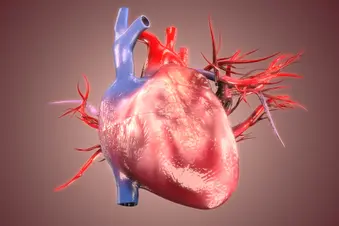
When you think of ankylosing spondylitis (AS), back pain is probably the first thing that comes to mind. But heart disease -- an umbrella term for several types of heart conditions -- should be on your radar, too.
Research suggests AS raises your risk for heart disease and stroke by as much as 60%. The possibility is highest among adults 20-39. Fortunately, there are things you can do to help lower your odds. Here’s how to care for your heart when you have AS.
Can Ankylosing Spondylitis Cause Heart Disease?
It depends. The inflammation that damages your joints can do the same to your heart, particularly the aorta. That’s the large artery that carries blood from the heart to the rest of the body.
“Over time, this can lead to high blood pressure, and also to aortic valve disease, which is when the valve between the left ventricle -- your heart’s main pumping chamber -- and the aorta doesn’t work properly,” says Elliott Antman, MD, a cardiologist at Brigham and Woman’s Hospital in Boston.
The valve begins to leak, which can lead to shortness of breath, chest pain, and dizziness.
“If you already have high blood pressure, the valve will leak even more,” Antman says.
People with ankylosing spondylitis are also at risk for other heart conditions. These include:
Heart arrhythmias. This is when your heart beats too fast or too slow. Problems with your heart’s electrical conduction system or other heart issues can trigger them.
Cardiomyopathy. This enlarges and weakens your heart muscle. That makes it harder to pump blood to the rest of the body. Without treatment, it could lead to heart failure.
Ischemic heart disease. Also called atherosclerosis, this type of heart disease cuts blood supply to your heart muscle.
Many people with AS are also placed on high doses of nonsteroidal anti-inflammatory drugs (NSAIDs) to treat symptoms.
“These cause your body to hold on to salt and water, which in turn increases blood pressure,” Antman says.
Research suggests people who take NSAIDs for a long time are at higher risk for a heart attack or stroke than those who don’t.
“We don’t rule these drugs out, as they can help a lot of patients, but we definitely try to keep people on the lowest dose possible for the shortest period of time,” Antman says.
Warning Signs to Watch for
If you have ankylosis spondylitis, you should be on the alert for signs of heart disease. These include:
- Shortness of breath
- Chest pain
- Dizziness
- Heart palpitations (you may feel like your heart is beating too fast or notice that it skips beats)
- Swelling of the legs, ankles, and feet
- Not able to exercise as much
Talk to your doctor if you notice any of these symptoms.
How to Help Your Heart
It’s important to make sure your heart is in good shape when you have ankylosing spondylitis. These tips can help:
Exercise often. It may be hard to stay active. But if you don’t, you’ll likely gain weight, which in turn will raise your blood pressure, Antman says. Aim for 30 minutes of low impact, moderate-intensity exercise, like walking or swimming, 5 days a week. Try to add 2 days of strength training. Yoga is also a good option. One small study found that people with AS who practiced yoga every day for 2 weeks reported less pain and lower blood pressure.
Know your numbers. This includes your blood pressure, cholesterol and triglyceride levels, blood glucose levels, and body weight.
“The more that these are under control, the better it is for your heart health,” Antman says.
If you’re prescribed medications to manage high blood pressure, high cholesterol, or type 2 diabetes, make sure you take them the way you’re supposed to. If you do have heart disease, ask your doctor if you should take a certain class of ankylosis spondylitis drugs known as TNF-inhibitors. A 2018 study found that patients with inflammatory arthritic conditions like AS who took these drugs had fewer cardiac events like heart attack or stroke.
Follow a heart-healthy diet. The two most well-studied eating patterns are the Mediterranean diet and the DASH diet, Antman says. Both are rich in fruits, veggies, whole grains, and healthy fats found in foods like fatty fish and olive oil. You also need to limit your salt intake. Aim for less than 1,500 milligrams daily, as it can worsen blood pressure.
Don’t smoke. It not only raises your risk of heart disease, but it also causes more joint damage in patients with ankylosis spondylitis.
When Should I See a Cardiologist?
Most of the time, your primary care doctor or rheumatologist can keep an eye on your heart, Antman says. But you should ask for a referral to a cardiologist if:
- You’re diagnosed with high blood pressure, cholesterol, or type 2 diabetes.
- Your doctor hears an abnormal sound (murmur) when listening to your heart with a stethoscope.
- You have symptoms that could be signs of heart disease, like breathlessness or chest pain.
Show Sources
Photo Credit: PALMIHELP / Getty Images
SOURCES:
Elliott Antman, MD, cardiologist, Brigham and Woman’s Hospital, Boston; past president, American Heart Association.
Spondylitis Association of America: “The Heart in Spondylitis.”
Spondylitis Association of America: “Exercise.”
Arthritis Foundation: “Smoking Worsens Ankylosing Spondylitis Damage.”
Annals of Neuroscience: “Potential Role of Yoga in the Management of Ankylosing Spondylitis: A Retrospective Study.”
Arthritis Research & Therapy: “Biologics and cardiovascular events in inflammatory arthritis: a prospective national cohort study.”